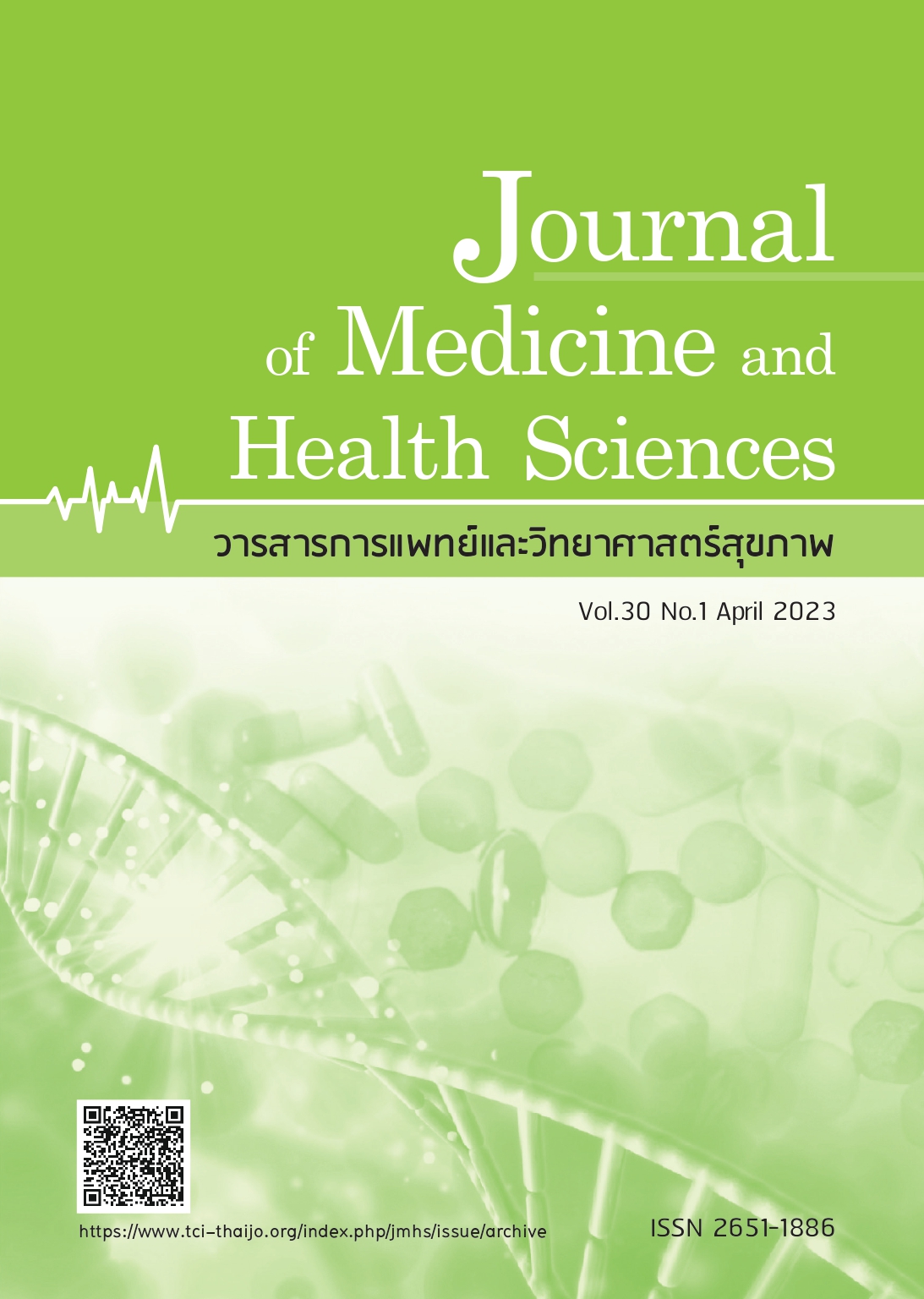Measurement of radiation dose by a radiologist from Transarterial Chemoembolization (TACE) intervention with optically stimulated luminescence
Keywords:
Transarterial chemoembolization, occupational dose, radiation dosimeter, optically stimulated luminescenceAbstract
The radiation dose received by radiologists during the transarterial chemoembolization (TACE) intervention procedure for the treatment of liver cancer patients and to help prevent future radiation risks for the radiologists. The purpose of this study was to measure the radiation dose at the lens, thyroid, and hand of radiologists during the TACE procedure. The risk and factors affecting radiation dose received by radiologists during TACE procedures were also evaluated. The data were from two radiologists performing TACE procedure with 16 patients. OSL nanoDots dosimeter were attached to outer center of thyroid shield, outside the lead glasses on both sides, and on both wrists of the radiologist to measure the radiation dose during TACE interventional radiology. The results showed that the mean time spent on TACE procedure was 70.8 minutes, the mean of X-ray fluoroscopy time was 19.1 minutes. Without using radiation protective equipment, radiologists received the average radiation doses to thyroid, left eye, right eye, left hand, and right hand were 21.8, 56.1, 6.4, 99.5, and 15.6 µSv, respectively. The maximum TACE cases that can be performed is 29 per month. While using the radiation protection equipment will reduce the doses to thyroid, left eye and right eye to 4.1, 13.1 and 1.2 µSv respectively, and a maximum of 128 procedures could be performed per month. In summary, the radiation dose received by the radiologist during the TACE procedure is within the radiation safety limit. The use of radiation protective equipment is important and necessary to reduce radiation hazards. Radiation workers should avoid radiation exposure when using high radiation doses and techniques.
References
Seals KF, Lee EW, Cagnon CH, et al.
Radiation-induced cataractogenesis: A
critical literature review for the Interventional
Radiologist. Cardiovasc Intervent Radiol
;39:151-60.
Stewart FA, Akleyev AV, Hauer-Jensen M,
et al. ICRP publication 118: ICRP statement
on tissue reactions and early and late
effects of radiation in normal tissues and
organs--threshold doses for tissue reactions
in a radiation protection context. Ann ICRP
;41:1-322.
Ferlay J EM, Lam F, Colombet M, et al.
Global cancer observatory: Cancer today:
Lyon, France: International Agency for
Research on Cancer.; 2020 [cited 2021
October 31]. Available from: https://gco.
iarc.fr/today/data/factsheets/populations/
-thailand-fact-sheets.pdf.
Chida K, Kaga Y, Haga Y, et al. Occupational
dose in interventional radiology procedures.
Am J Roentgenol 2013;200:138-41.
Whitby M, Martin CJ. A study of the
distribution of dose across the hands of
interventional radiologists and cardiologists.
Br J Radiol 2005;78:219-29.
Hidajat N, Wust P, Felix R, et al. Radiation
exposure to patient and staff in hepatic
chemoembolization: risk estimation of
cancer and deterministic effects. Cardiovasc
Intervent Radiol 2006;29:791-6.
Martin CJ. A review of radiology staff doses
and dose monitoring requirements. Radiat
Prot Dosimetry 2009;136:140-57.
Chida K, Kato M, Kagaya Y, et al. Radiation
dose and radiation protection for patients
and physicians during interventional
procedure. J Radiat Res 2010;51:97-105.
Sanchez RM, Vano E, Fernandez JM, et al.
Measurements of eye lens doses in
interventional cardiology using OSL and
electronic dosemeters†. Radiat Prot
Dosimetry 2014;162:569-76.
Krisanachinda A, Srimahachota S,
Matsubara K. The current status of eye
lens dose measurement in interventional
cardiology personnel in Thailand. Radiol
Phys Technol 2017;10:142-7.
Landauer. nanoDot™ Dosimeter: Patient
monitoring solutions [cited 2021 October 31].
Available from: https://www.landauer.
com/product/nanodot.
Hamann E, Koenig T, Zuber M, et al.
Performance of a medipix3RX spectroscopic
pixel detector with a high resistivity
gallium arsenide sensor. IEEE Trans Med
Imaging 2015;34:707.
Dolly S. NISTX Calculator: Solutio in silico;
[cited 2020 November 15]. Available
from: http://solutioinsilico.com/medicalphysics/applications/nist-lookup.
php?ans=0.
Funama Y, Nagasue N, Awai K, et al.
Radiation exposure of operator performing
interventional procedures using a flat
panel angiography system: Evaluation
with photoluminescence glass dosimeters.
Jpn J Radiol 2010;28:423-9.
Degiorgio S, Gerasia R, Liotta F, et al.
Radiation doses to operators in
hepatobiliary interventional procedures.
Cardiovasc Intervent Radiol 2018;41:772-80.
Shah P, Khanna R, Kapoor A, et al. Efficacy
of RADPAD protection drape in reducing
radiation exposure in the catheterization
laboratory—First Indian study. Indian
Heart Journal 2018;70:S265-S8.
Palácio EP, Ribeiro AA, Gavassi BM, et al.
Exposure of the surgical team to ionizing
radiation during orthopedic surgical
procedures. Rev Bras Ortop 2014;49:227-32.
Wilson-Stewart KS, Fontanarosa D, Li D,
et at.Taller staff occupationally exposed
to less radiation to the temple in cardiac
procedures, but risk higher doses during
vascular cases. Scientific Reports 2020;10:
Mechlenburg I, Daugaard H, Soballe K.
Radiation exposure to the orthopaedic
surgeon during periacetabular osteotomy.
Int Orthop 2009;33:1747-51.
Boddu SR, Corey A, Peterson R, et al.
Fluoroscopic-guided lumbar puncture:
fluoroscopic time and implications of
body mass index--a baseline study. Am J
Neuroradiol 2014;35:1475-80.
Kim HO, Lee BC, Park C, et al. Occupational
dose and associated factors during
transarterial chemoembolization of
hepatocellular carcinoma using real-time
dosimetry: A simple way to reduce
radiation exposure. Medicine (Baltimore)
;101:e28744.
Downloads
Published
How to Cite
Issue
Section
License

This work is licensed under a Creative Commons Attribution-NonCommercial-NoDerivatives 4.0 International License.



